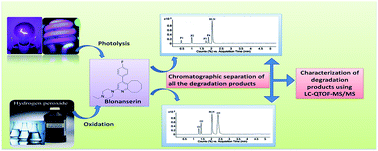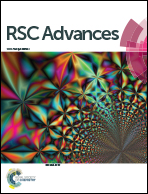Characterization of stress degradation products of blonanserin by UPLC-QTOF-tandem mass spectrometry†
Abstract
Stress studies of drugs are very important in the drug development process. As per regulatory guidelines forced degradation studies and characterization of resulting degradation products is mandatory to establish inherent stability of the drug. Blonanserin is an important drug used for the treatment of schizophrenia. As there are no reports in the literature on the degradation study of the drug, the present work has been undertaken. Blonanserin was subjected to forced degradation studies under the conditions of hydrolysis (acidic, basic and neutral), oxidation, photolysis and thermal stress conditions. A selective separation was achieved on a Waters BEH C18 analytical column (50 mm × 2.1 mm, 1.7 μm). The structural characterization of the degradation products was performed using UPLC/QTOF/MS/MS. The drug was found to degrade in oxidative and photolytic conditions, whereas it was stable under hydrolytic, photolytic and thermal stress conditions. A total of seven hitherto unknown degradation products were characterized and probable mechanisms have been proposed for the formation of the degradation products. Moreover, in silico toxicity of all degradation products was also evaluated.


 Please wait while we load your content...
Please wait while we load your content...